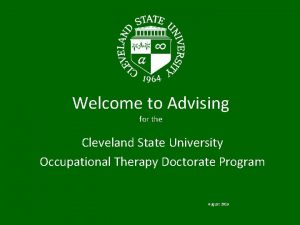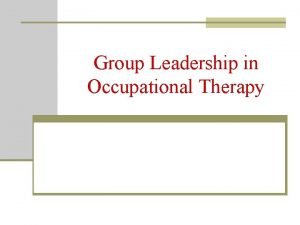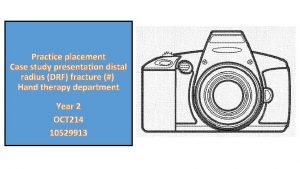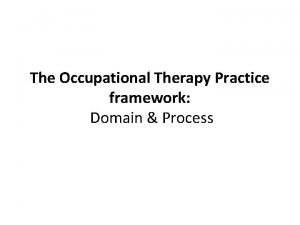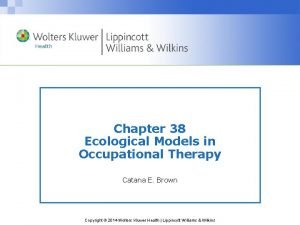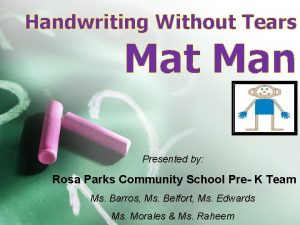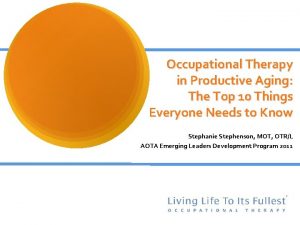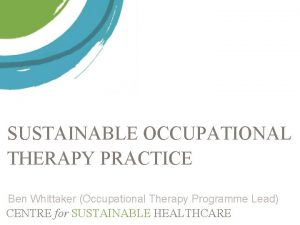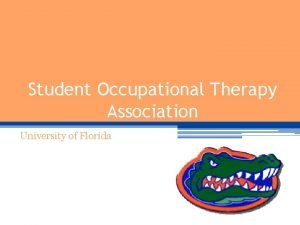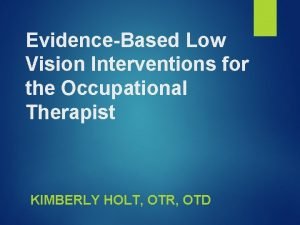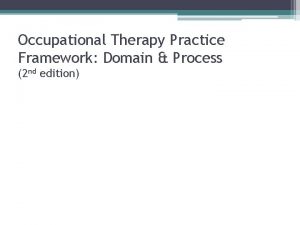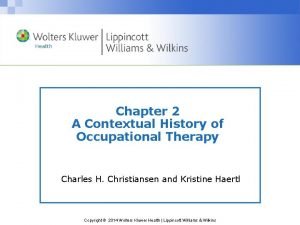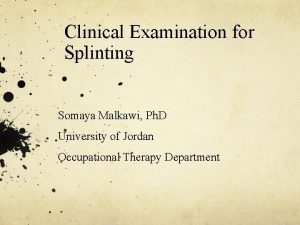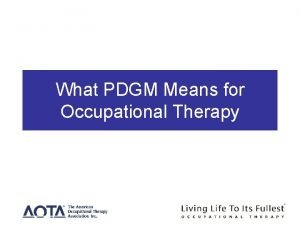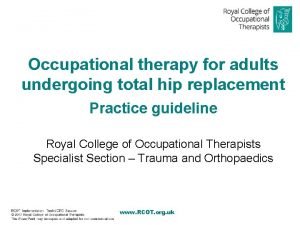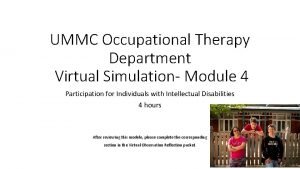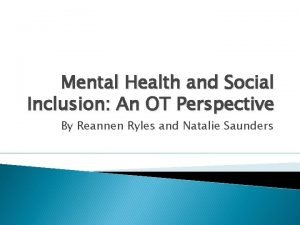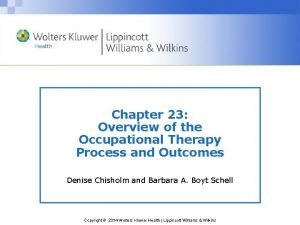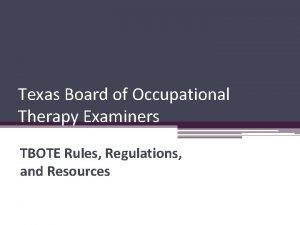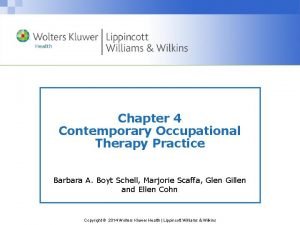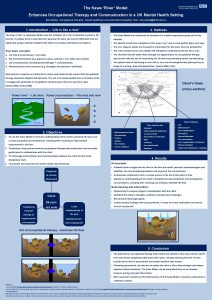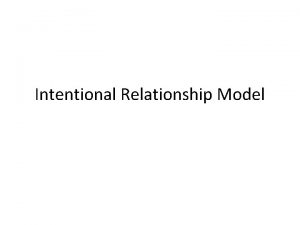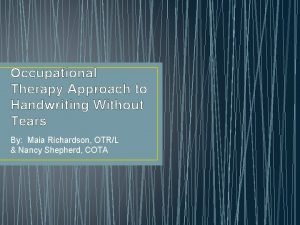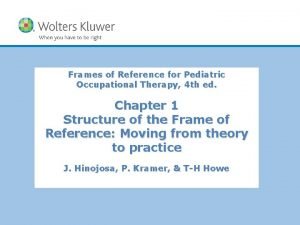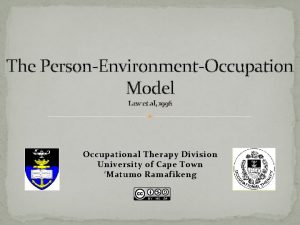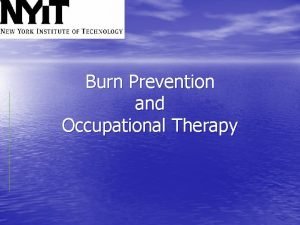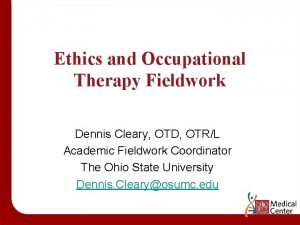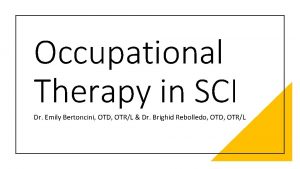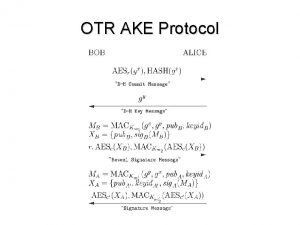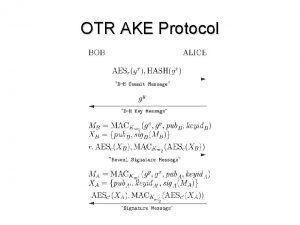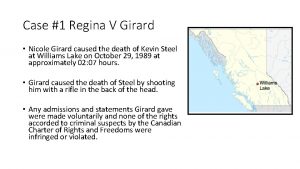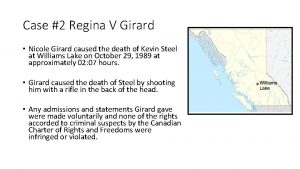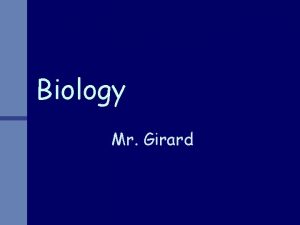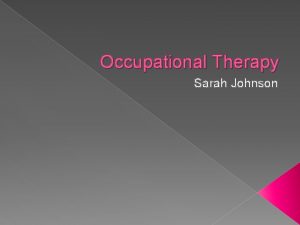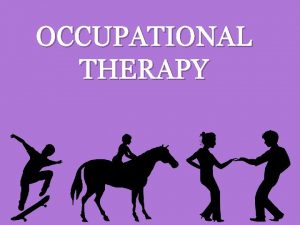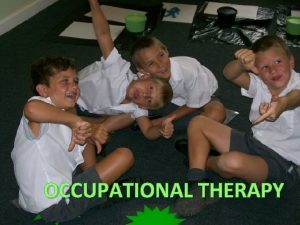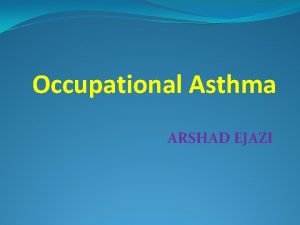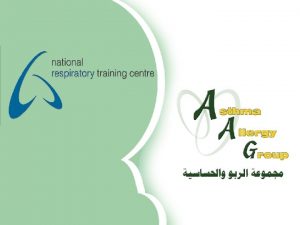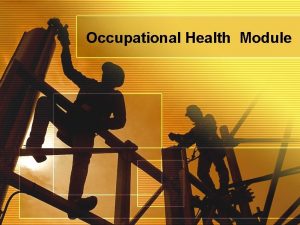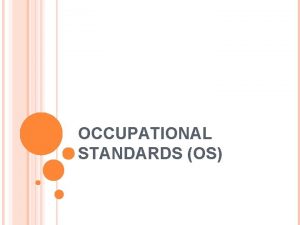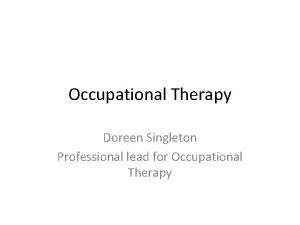OCCUPATIONAL THERAPY Laura Golden OTR OTD Megan Girard






























- Slides: 30

OCCUPATIONAL THERAPY Laura Golden, OTR, OTD Megan Girard, OTR/L, MOT

AGENDA Defining occupation Factors that influence occupation Occupational Therapy and IDD

WHAT IS OCCUPATION?

DEFINING OCCUPATION 1 a : an activity in which one engages b : the principal business of one's life : VOCATION 2 a : the possession, use, or settlement of land : OCCUPANCY b : the holding of an office or position 3 a : the act or process of taking possession of a place or area : SEIZURE b : the holding and control of an area by a foreign military force c : the military force occupying a country or the policies carried out by it

WHAT IS OCCUPATION? “The ordinary and familiar things that people do every day” - Christiansen, Clark, Kielhofner & Rogers, 1995

OCCUPATIONS o o o Create identity Establish meaning Are supported by skills, capacities, interests and the environment Are goal directed, purposeful, and meaningful to the individual Can be used to learn skills, strengthen skills, and develop functional behaviors

THE IMPORTANCE OF OCCUPATION Reduces the risk for disabilities (Mendes de Leon et al, 1999) Are as protective against the risk of mortality as physical activities (Glass et al, 1999) Protects against cognitive decline and depressive symptoms (Bassuk et el, 1999; Hultsche et al 1999)

PERFORMANCE IN AREAS OF OCCUPATION Activities of Daily Living Instrumental Activities of Daily Living Work Play and Leisure Education Social Participation / Engagement Rest and Sleep

SUPPORTING PARTICIPATION THROUGH OCCUPATION

PARTICIPATION Occupational Performance, Participation, and Volition Person Environm ent Occupatio n

VOLITION Meaning, choice, and motivation How a person ascribes meaning to an activity o A person’s motivation for engagement in the occupation o How a person feels, thinks, and chooses the activities in which to engage

FACTORS THAT INFLUENCE OCCUPATION Client Factors and Performance Skills - an individual’s body structure and motor skills, cognitive skills, adaptive behavior, communication and interaction skills. Performance patterns - an individual’s habits, routines, and roles used to carry out daily occupations. Context - any of the cultural, physical, social, personal, spiritual, temporal, and virtual conditions, either internal or external, that surround a client and influence performance. Activity demands are the characteristics of the activity or task that influence its execution.

OCCUPATIONAL ENRICHMENT Activities o o o have clear goals Involve concentration Are doable Allow for choice Provide immediate feedback Provide challenge that is equal to capabilities

WHAT IS OCCUPATIONAL THERAPY?

OCCUPATIONAL THERAPY “Occupational therapy is a client-centered health profession concerned with promoting health and well being through occupation. The primary goal of occupational therapy is to enable people to participate in the activities of everyday life. ” 2012 WFOT,

OCCUPATIONAL THERAPY Occupational therapy services may include: o o o o comprehensive physical and cognitive evaluation comprehensive evaluations of the home and other environments comprehensive evaluations of occupations recommendations for adaptive equipment and training in its use recommendations for adapting the environment guidance and education for family members and caregivers Individual or group intervention treatment and skills training/restoration “Occupational therapy does not seem to be bound to the concept of disease, instead it focuses upon the success of individuals in finding fulfillment through human activity” - Engelhardt, 1976

OCCUPATIONAL THERAPISTS Help people across the lifespan participate in the things they want and need to do through therapeutic use of everyday activities (occupations).

OCCUPATIONAL THERAPISTS Look at and comprehensively analyze the interaction between the individual, the occupations that they engage in, and the environment, and provide intervention and adaptations to promote participation in activities meaningful to the individual. Help individuals develop new skills, modify the activity, or modify the environment to create the best person-activity-environment match.


BARRIERS TO OCCUPATIONS

OCCUPATIONAL ALIENATION When a person � is insufficiently involved in choosing meaningful activities � When a person does not receive the supports needed to engage in occupations This can lead to experiences of disconnectedness, limited self-expression, or a sense of meaninglessness - Townsend & Wilcock, 2004

“Restriction from participation causes physiological deterioration leading to the loss of ability to perform competently in daily life” Kielhofner, 1992

OCCUPATIONAL ALIENATION CYCLE Need for Support Decline in Health and Well-being Occupational Oppression Loss of Identity and Meaning Occupational Alienation Occupational Deprivation Occupational Injustice

OCCUPATION AND IDD: COMMON PICTURE Segregated from mainstream life Dependent on parents or caregivers for assistance, emotional support, and friendship Have limited ability to build skills outside of a segregated setting Have restricted life choices and occupational roles

HOW OT SUPPORTS THE IDD POPULATION

OCCUPATIONS o o o Should be goal directed, purposeful, and meaningful to the individual Strengthen identity Strengthen meaning Should be supported by skills, capacities, interests and the environment Can be used to learn skills, strengthen skills, and develop functional behaviors

OT AND IDD Provide training and adaptation to improve Life Skills personal and physical Communicat ion and Vocational needs and routine daily Mobility Skills living skills Provide strategies to address behavioral OT Sensory concerns Regulation Social Skills Ensure health needs are met Health Behavior Ensure sensory needs Promotion Managemen Skills t Skills are met Provide mobility and/or communication training

FINAL NOTE “The capacity to do something useful is the key to personhood” - Bateson, 1996

FOR OT CONSULTATION SERVICES: Transition Support Team � MBPprogram@mhmrtc. org Laura Golden � Laura. Golden@mhmrtc. org Megan Girard � Megan. Girard@mhmrtc. org

REFERENCES o AOTA. About Occupational Therapy. http: //www. aota. org/about-occupationaltherapy. aspx o Bassuk SS, Glass TA, Berkman LF. Social disengagement and incident cognitive decline in communitydwelling elderly persons. Annals of Internal Medicine. 1999; 131: 165– 173. Glass T. A. , Mendes de Leon C. , Marottoli R. A. , Berkman L. F. , 1999. Population based study of social and productive activities as predictors of survival among elderly Americans. British Medical Journal 319: 478 -483. Hultsch, D. F. , Hertzog, C. , Small, B. J. , & Dixon, R. A. (1999). Use it or lose it: Engaged lifestyle as a buffer of cognitive decline in aging? Psychology and Aging, 14, 245– 263. Mendes de Leon, C. F. , Glass, T. A. , Beckett, L. A. , Seeman, T. E. , Evans, D. A. , Berkman, L. F. , 1999. Social networks and disability transitions across eight intervals of yearly data in the New Haven EPESE. J. Gerontol. Soc. Sci. 54 B, S 162–S 172. Reilly, M. (1962). Occupational therapy can be one of the greatest ideas of 20 th century medicine. 1961 Eleanor Clarke Slagle Lecture. American Journal of Occupational Therapy, 16, 1 -9. Christiansen, C. , Clark, F. , Kielhofner, G. , & Rogers, J. (1995). Position Paper: Occupation, 49, 10151018. Cronin, A. (2013). Adults with developmental and intellectual disabilities in nursing home settings. OT Practice, 16, 15, CE-1 – CE-8. Baum, C. Manville, Dunn, W. , & Law, M. C. (2005). Measuring occupational performance : supporting best practice in occupational therapy. 2 nd ed. Thorofare (N. J. ): Slack. Hayes, K. & Gallagher Worthley, J. (2015). Facilitating Volition: Social Interaction and Activity Participation for Adults with Intellectual and Developmental Disabilities. AOTA Special Interest Section Quarterly. 35(4). Kielhofner, G. (1992). Conceptual foundations of occupational therapy. Philadelphia: F. A. Davis. Law M, Cooper B, Strong S, Stewart D, Rigby P, Letts L. (1996). The Person-Environment-Occupational Model: A transactive approach to occupational performance. CJOT 63(1), 9 -23. Occupational Therapy Practice Framework: Domain and Process. American Journal of Occupational Therapy, November/December 2002, Vol. 56, 609 -639. Townsend, A. & Wilcock, A. A. (2004). Occupational justice and client-centred practice: A dialogue. Canadian Journal of Occupational Therapy 71, 2, 75 -87 Webster Dictionary o o o o
 Bioness integrated therapy system price
Bioness integrated therapy system price Cleveland state university occupational therapy
Cleveland state university occupational therapy Lmu otd
Lmu otd Leadership in occupational therapy
Leadership in occupational therapy Creek 2003 occupational therapy process
Creek 2003 occupational therapy process Occupational therapy practice framework
Occupational therapy practice framework Ehp occupational therapy
Ehp occupational therapy Mat man drawing
Mat man drawing Ot
Ot Occupational therapy and environmental sustainability
Occupational therapy and environmental sustainability University of cumbria occupational therapy
University of cumbria occupational therapy Florida occupational therapy association
Florida occupational therapy association Eccentric viewing techniques occupational therapy
Eccentric viewing techniques occupational therapy Occupational therapy practice framework domain and process
Occupational therapy practice framework domain and process Alert program occupational therapy
Alert program occupational therapy Ruth robinson occupational therapy
Ruth robinson occupational therapy Boley gauge occupational therapy
Boley gauge occupational therapy Pdgm home health occupational therapy
Pdgm home health occupational therapy Occupational therapy intervention plan for hip arthroplasty
Occupational therapy intervention plan for hip arthroplasty Ummc occupational therapy program
Ummc occupational therapy program Remedial vs compensatory approach occupational therapy
Remedial vs compensatory approach occupational therapy Occupational therapy process diagram
Occupational therapy process diagram Occupational therapy spain
Occupational therapy spain Uniform terminology for occupational therapy
Uniform terminology for occupational therapy Texas occupational therapy board
Texas occupational therapy board Contemporary occupational therapy practice
Contemporary occupational therapy practice Kawa river model
Kawa river model Intentional relationship model modes
Intentional relationship model modes Handwriting without tears
Handwriting without tears Pediatric occupational therapy frames of reference
Pediatric occupational therapy frames of reference Peo framework occupational therapy
Peo framework occupational therapy

